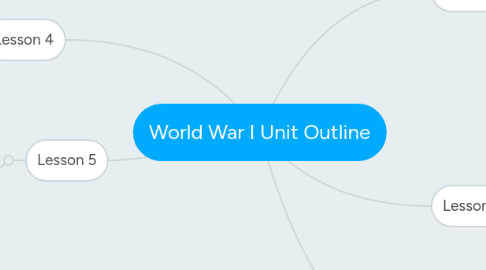
1. Lesson 4
1.1. US.29 Analyze the aims and negotiating roles of world leaders, including Woodrow Wilson’s Fourteen Points, and the causes and effects of the United States’ rejection of the League of Nations on world politics.
1.1.1. Take notes on Woodrow Wilson's Fourteen Points.
1.1.1.1. Students will get in group of 3 or 4, and discuss which one of the Fourteen Points they feel is most important and why. They ill share with the class.
1.1.1.1.1. Do a worksheet on the League of Nations.
2. Lesson 5
2.1. Review Day!
2.1.1. Students will make up any work or notes they have missed from chapter 9.
2.1.1.1. The teacher will lead the students in a review game.
2.1.1.1.1. Students will be given time to ask any questions they may have.
3. Lesson 1
3.1. Section 1: The United States Enters WW1
3.1.1. US.26 Explain the causes of World War I in 1914 and the reasons for the initial declaration of United States’ neutrality.
3.1.1.1. US. 27 Justify with supporting detail from text, the reasons for American entry into World War I, including the use of unrestricted submarine warfare by the Germans, the Zimmerman Note, the defense of democracy, and economic motivations.
3.1.1.1.1. Students will turn to page 325 in their textbooks and look at the debates in history. Students will look at the debate on wether or not America should have remained neutral in the war and then answer the document based questions. Students will then be forming their own opinion on the war. Students will justify for themselves the reasons for entering the war based on events such as unrestricted submarine warfare, the Zimmerman Note, the defense of democracy, and economic motivations. The students will then divide themselves into sides. One side will be for American entry into the war and the other will be against. The teacher will lead a debate based on the students justifications and opinions.
3.1.1.2. Students will complete an exit ticket explaining the causes of WWI at the end of class. Students will have read Section 1, gone through notes in class, and viewed a newspaper article about the sinking of the Lusitania before completing this assignment.
4. Lesson 3
4.1. US.28 Identify and explain the impact of the following events and people during World War I: (G, H, P, TN) • Major turning points, Impact of trench warfare, Use of new weapons and technologies, Herbert Hoover, John J. Pershing and the American Expeditionary Force, Doughboys, Alvin C. York
4.1.1. Watch video on trench warefare
4.1.1.1. Have a gallery walk with notes on the section as well as pictures of trench warfare and other pictures of the war
4.1.1.1.1. Break into small groups, give each group a bullet point from the standard. Have each group use their books and their phones to find 5 important or impactful thing for their topic to share with the class. The students will write these down for notes.
5. Lesson 2
5.1. US.30 Analyze the political, economic, and social ramifications of World War I on the home front, including the role played by women and minorities, voluntary rationing, the Creel Committee, opposition by conscientious objectors, and the case of Schenck v. United States.
5.1.1. Watch video on how the homefront helped the war effort.
5.1.1.1. Read a primary document on African Americans in the war.
5.1.1.1.1. Read, discuss, and answer the questions on page 331 on Analyzing supreme court cases.
